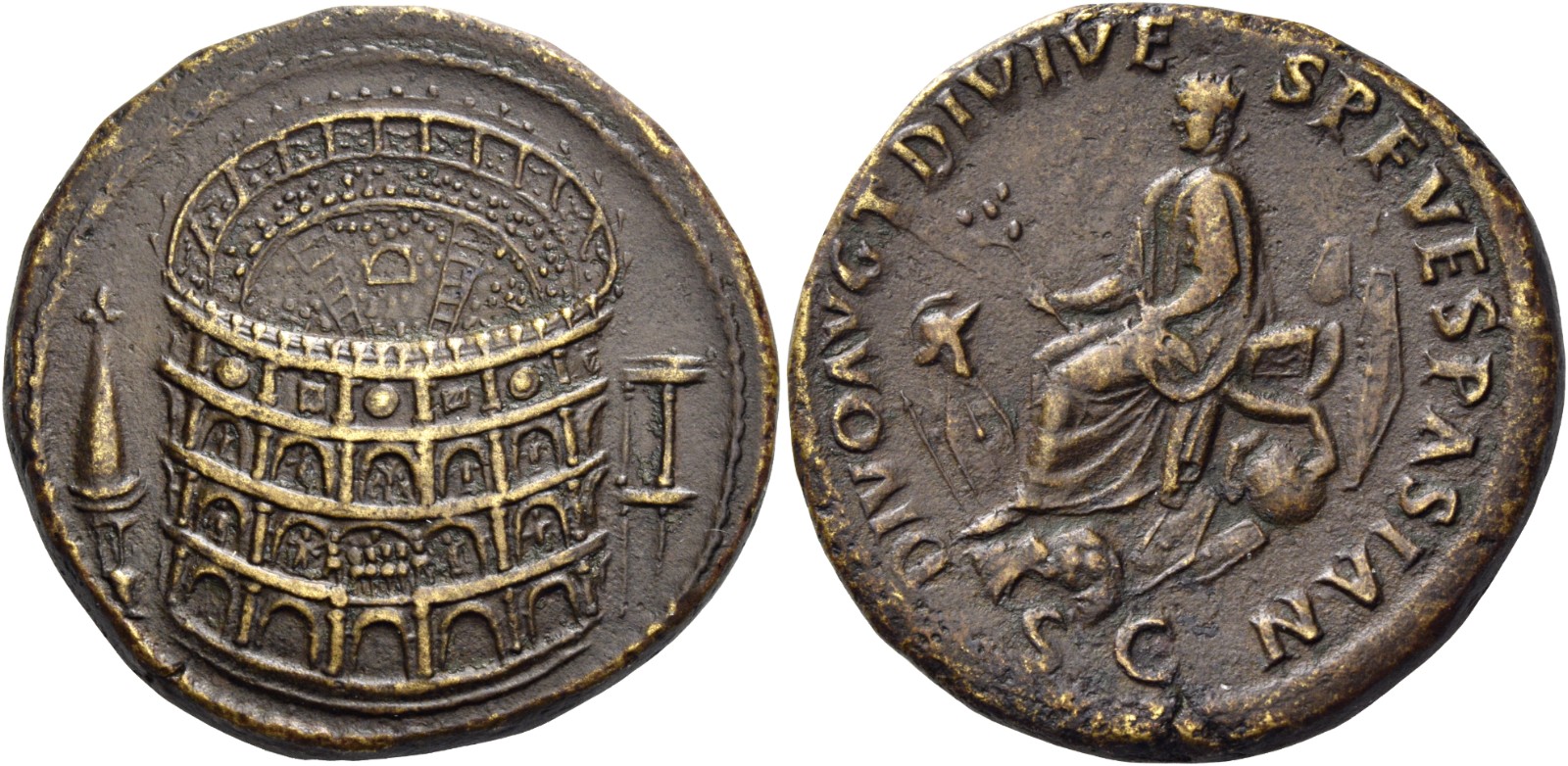S 116 - Rome (Domitian), sestertii (81-82 CE)
From SILVER
81 CE - 82 CE Bronze
Description
| ObverseInscription or printing placed on the obverse.: | Aerial view of the Flavian Amphitheatre (the Colosseum), on l., Meta Sudans and on r., porticoed building. |
| ReverseInscription or printing placed on the reverse.: | DIVO AVG T DIVI VESP F VESPASIAN SC (Latin).Titus seated l. on curule chair, holding branch and roll, around, arms, below, S – C |
Mint and issuing power
| MintIdentifies the place of manufacture or issue of a numismatic object.: | Rome | Ancient regionAncient region.: | Latium | Modern countryModern country: Italy | AuthorityIdentifies the issuing power. The authority can be "pretended" when the name or the portrait of X is on the coin but he/she was not the issuing power. It can also be "uncertain" when there is no mention of X on the coin but he/she was the issuing power according to the historical sources: | Domitian (Roman emperor, 81-96 AD) |
Chronology
| FromIdentifies the initial date in a range assigned in a numismatic context. | 81 CE | toIdentifies the final date in a range assigned in a numismatic context.. | 82 CE | PeriodTime period of the numismatic object.: Roman from 30 BC |
Physical description
| MetalThe physical material (usually metal) from which an object is made.: | Bronze |
Median weightMedian of the weights of numismatic objects (in grams). in grams | 25.00 | DenominationTerm indicating the value of a numismatic object. Examples: tetradrachm, chalkous, denarius.: | sesterce | StandardStandard.: |
Image

S 116 - Rome, sesterce, 81-82 BC.jpg [1]
References
| Die study referencePublication of the study: | Elkins 20061Elkins 2006 | ||
| Coin series referenceReference to coin series study: | RIC II.12RIC II.1, n° 131 | ||
Obverse dies distribution
no distribution is available
Reverse dies distribution
no distribution is available
Quantification
| Number of obversesNumber of obverse dies. ᵖ (o) | 1 | Number of singletons (o1)The number of singleton coins. ᵖ | |
| Number of reverse diesNumber of reverse dies. (r) | 2 | Number of coinsNumber of coins. (n) | 10 |
| Coins per obverse dieNumber of coins per obverse die. (n/o) | 10 | Coins per reverse dieNumber of coins per reverse die. (n/r) | 5 |
| Reverse per obverse ratioRatio of obverse dies divided by reverse dies. (r/o) | 2 | Percentage of singletons (o1)number of coins (n) divided by the number of singletons (o1) ᵖ | % |
| Original number of dies (O) (Carter 1983 formula)The estimation of the number of coins according to Carter 1983 ᵖ | 1.02 | Coins struck if 20,000 as average productivity per dieCoins made if the average productivity for obverses (according to Carter) is 20,000. ᵖ | 20,400 |
| Original number of dies (O) (Esty 2011 formula)The estimation of the number of coins according to the singleton formula in Esty 2011 ᵖ (O) | 1.11 | Survival rate if 20,000 as average productivity per dieSurvival rate if average productivity is 20,000. ᵖ | 0.00049 |
| Coverage (o = % of O) (Esty 1984 formula)Esty 1984 - coverage (% of O) ᵖ (o = % of O) | % | Die productivity if survival rate 1/2,000Average productivity if survival rate is 1/2,000. ᵖ | 19,607.84 |
| Weight of silver (in kg) if 20,000 coins per die (O = Carter formula)Carter 1983 * Median weight * 20000 (*10 if gold or electrum) ᵖ | n.a. | Die productivity if survival rate 1/5,000Average productivity if survival rate is 1/5,000. ᵖ | 49,019.61 |
Remarks
Most likely one single workstation